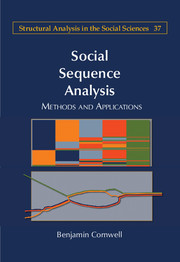Book contents
- Frontmatter
- Contents
- List of Figures
- List of Tables
- Preface
- Acknowledgments
- PART I INTRODUCTION
- PART II THEORETICAL BACKGROUND
- 2 Theoretical Foundations of Social Sequence Analysis
- PART III SOCIAL SEQUENCE ANALYSIS CONCEPTS AND TECHNIQUES
- PART IV NEW DIRECTIONS IN SOCIAL SEQUENCE ANALYSIS
- PART V CONCLUSIONS
- Appendix A Recent Whole-Sequence Pattern Analyses
- Appendix B Linkage Criteria for Agglomerative Hierarchical Clustering
- References
- Index
- Recent Books in the Series (continued from page iii)
2 - Theoretical Foundations of Social Sequence Analysis
from PART II - THEORETICAL BACKGROUND
Published online by Cambridge University Press: 05 July 2015
- Frontmatter
- Contents
- List of Figures
- List of Tables
- Preface
- Acknowledgments
- PART I INTRODUCTION
- PART II THEORETICAL BACKGROUND
- 2 Theoretical Foundations of Social Sequence Analysis
- PART III SOCIAL SEQUENCE ANALYSIS CONCEPTS AND TECHNIQUES
- PART IV NEW DIRECTIONS IN SOCIAL SEQUENCE ANALYSIS
- PART V CONCLUSIONS
- Appendix A Recent Whole-Sequence Pattern Analyses
- Appendix B Linkage Criteria for Agglomerative Hierarchical Clustering
- References
- Index
- Recent Books in the Series (continued from page iii)
Summary
Regardless of whether we are considering people, organizations, cities, or nations, all social actors are connected to each other and to larger society through a dynamic series of ordered states and events. This book details the family of analytic methods that are designed to identify overarching patterns in the sequences through which actors experience these processes. This involves the systematic, empirical analysis of narratives, interdependencies and contingencies among social phenomena, and temporal and spatial regularities. This is a crucial task, as social structure, and actors' positions within it, are revealed and constituted through these aspects of social sequences (Bales 1951; Bourdieu 1984; Blumer 1969; Camic 1986; Collins 2004; Gershuny 2000; Giddens 1984; Goffman 1959, 1967; Nadel 1957; Parsons 1951; Sacks 1995; Schutz [1932] 1967; Sorokin and Berger 1939; Sorokin and Merton 1937; Strauss 1993; White 2008; Zerubavel 1981). Knowing how to detect patterns in the order in which social phenomena unfold yields unparalleled insight into social structure. The purpose of this chapter is to clarify what social sequences are and to discuss why it is so important to understand them.
What Are Social Sequences?
Sequences are sets of ordered things – states, events, activities, preferences, or other phenomena. These elements may be social in nature (e.g., social activities) or otherwise (e.g., proteins or nucleotides), but this book is concerned only with socialsequences. Knowing that time plays a large role in structuring social action, we typically think of temporal order when we think about sequences (e.g., referring to events that unfold over a period of time). This suggests the following straightforward definition: “[S]ocial sequences are empirically observed, temporally ordered regularities” (Stovel 2010:5). Indeed, the majority of sequence analyses in contemporary social science are concerned with biographical, historical, or other forms of temporal order.
But scholars are often concerned instead with various types of sequences in which order is not temporally defined. A social sequence may also reflect spatial order, preference order, hierarchical order, logical order, a cognitive schema or script, or other types of order. An urban development plan, for example, might consist of the logically planned phases or steps (which may or may not be implemented in practice) that are designed to revitalize a neighborhood (logical order).
Information
- Type
- Chapter
- Information
- Social Sequence AnalysisMethods and Applications, pp. 21 - 56Publisher: Cambridge University PressPrint publication year: 2015
Accessibility standard: Unknown
Why this information is here
This section outlines the accessibility features of this content - including support for screen readers, full keyboard navigation and high-contrast display options. This may not be relevant for you.Accessibility Information
- 2
- Cited by
